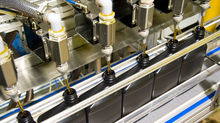PAG’s Cannot Form Varnish

Maintenance Engineers have been dealing with the problems of varnish formation for so long that it seems hard to believe when they are told that one type of lubricant cannot form varnish. However, PolyAlklene Glycols (PAG’s) shut down every chemical mechanism that is known to form varnish in other types of lubricants.
1. PAG’s reduce in molecular weight as they oxidize. The oxidation of PAG’s result in the fracturing of the polymer and the formation of low molecular weight ethers and glycols. This happens at such a slow rate under recommended operational temperatures that changes in the average molecular weight of PAG’s over time are undetectable. It is the growth in molecular weight that creates a lubricant component that can no longer be kept in suspension that is known to create solids in hydrocarbon and ester-based lubricants.
2. The products of oxidation are readily dissolved by PAG’s. This is because the combination of ethers and alcohols of the PAG are chemically similar to the peroxides, alcohols, ketones, and acids that can all be formed by oxidation. When a lubricant degrades into oxidation products that are chemically dissimilar to the base fluid, varnish deposits often occur.
3. Performance additives do not form solids. The higher solvency of PAG’s keeps a wide variety of chemical functional groups in solution. Lubricants that do not have the solvency of PAG’s may use performance additives that are less effective, coupled to polymers that improve solubility.
4. PAG’s have high detergency. The polar chemistry of PAG’s readily wet metal surfaces. As a result, the lubricant itself associates with the metal surfaces and dissolves most types of deposits from the metal surface. Lubricants that are not detergent in nature tend to form tenacious solids that require chemical flushing with turbulent flow to cleanse the metal surfaces.
5. Every third atom in a PAG is oxygen. This is important during high heat conditions where coking can occur. With every third atom being oxygen, there is no possibility for 6 carbons to combine to form the more stable aromatic ring structure, associated with varnish, regardless of the heat or stress. Therefore, graphitic structures cannot form. Also, soot formation is a problem for any lubricant that has high carbon content.
In applications where varnish-like deposits have been found when using PAG lubricants, the source of the varnish has always been traced back to foreign oil contamination. Therefore, it is very important to remove as much of the previous fluid from the system as practical and take preventative measures to keep foreign fluids out of the PAG. Knowing this, the maintenance engineers have it within their control to successfully operate with PAG’s and lubricate their equipment without varnish problems for many years to come.























